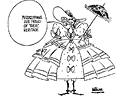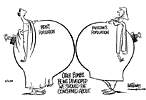 |
||||
|
Opus 58: Woman Editorial Cartoonist Wins Pulitzer (April 25, 2001). The Pulitzer Board picked Ann Telnaes for the prize in editorial cartooning. Telnaes is not the first woman to win in this category, but she joins a pretty exclusive club: the only other female editorial page ink-slinger with a Pulitzer is Signe Wilkinson of the Philadelphia Daily News, who won in 1992. Two winners in the last decade actually represents a fairly high percentage when we consider that there are only about a half-dozen full-time practicing women editorial cartoonists out of a total editoonery population of probably 150-175. It’s the "only about a half-dozen" part that is the disgraceful part—and that’s an indictment of the society as a whole rather than the profession within it. Telnaes has another claim to a small group membership: she has no home-base paper, so her cartoons find their way into print only through syndication (Los Angeles Times Syndicate, now Tribune Media Service). This tiny club includes only three others who have Pulitzers (and only one of those, we might say, is, strictly speaking, an editorial cartoonist): Herblock (NEA, 1942), Garry Trudeau (with Doonesbury, Universal Press, 1975), and Berk Breathed (with Bloom County, Washington Post Writers Group, 1987). Bill Mauldin won in 1945 and while United Feature Syndicate is usually cited with him in lists of winners, he had a home-base paper: he was still in the service then and on staff at Stars and Stripes. Given a detectable trend in newspaper editorial cartooning away from staff editorial cartooning to syndicated material, Telnaes’ win raises a flag over turf that may, eventually, be the only turf in which an editorial cartoonist can plow a furrough. In any event, she told me she hopes her win will encourage other freelance unaffiliated editorial cartoonists who toil away without benefit of a home-base paper. Telnaes’ win chalks another milestone in the Pultizer pavement: for at least the second year in a row, the Prize went to a cartoonist with a somewhat unconventional style. (Last year, it went to Joel Pett of the Lexington Herald-Leader.) Telnaes is not a Jeff MacNelly clone. Or a Herblock clone. Or a Feiffer clone. In fact, her cartooning style, derived directly from her earlier career in animation, is unique among editorial cartoonists. And she hits hard and well. She often nails her subject from an angle almost no one else seems to see. Her cartoons are usually deft deployments of visual metaphors, the very best manifestation of editorial cartooning. And that, too, is unusual in a time when many editorial cartoonists produce more verbal gags than visual metaphors. Consequently, while it is generally accepted that winning a Pultizer is an honor, Telnaes' win this year elevates the status of the Prize—not the other way around. The two other finalists this year were Clay Bennett of the Christian Science Monitor and Ben Sargent of the Austin American-Statesman. Sargent won in 1982. The Pulitzer Board notified Telnaes of the decision by telegram. Normally, an editorial cartoonist’s home paper is notified—the editor or publisher; then (usually with some ceremony) the editorial staff descends on the cartoonist in his or her cluttered cubicle, uncorking the champagne upon entering. But since Telnaes has no home paper, she got the word by telegram. And the telegram didn’t arrive until the day after she’d heard the announcement on one of the Internet audio news sites. She was by herself in her home studio, she told me. She jumped up and stared at the monitor screen in disbelief. Then, since she was up, she took her dog, Duncan, for a walk. (And while she walked, she phoned her husband—still not quite sure she’d heard correctly.) Telnaes started out to be a veterinarian but got angry and became an editorial cartoonist. Born in Sweden, she became a U.S. citizen at about the age of thirteen when her parents did. Her Norwegian father worked for IBM, and the family was transferred around a good deal. They lived in this country until she was six, left, then returned three years later. By the time she went to college at Arizona State University, her ambition to be a vet had been dashed on the rocks of her aptitude: "I found out I really stink at science," she told me. But she always liked to draw, so she majored in art with a minor in journalism. Unlike most of today’s editorial cartoonists, she did not work on the campus newspaper. "I didn’t have any interest in editorial cartooning then," she said. "I wasn’t very political at the time. I wasn’t—I hate to say this—but I didn’t keep up on issues. I kind of got into it later than most." When she realized that someone could actually make money in art by going into the commercial end of it, she also realized that if she was going to compete, she needed to go to art school. So she left Arizona State after two-and-a-half years and enrolled at the California Institute of the Arts near Los Angeles. Cal Arts has its roots in the Chouinard Art School, an early training ground for Disney Studio, and offers, today, an animation program geared to the needs of Disney. Telnaes majored in character animation, graduated with a BSA in 1984, and freelanced in animation for several years thereafter—sometimes for Disney, sometimes for smaller studios; sometimes in L.A., once in London and once in Taiwan. She then worked in Disney’s imagineering division as a show designer for six years as a show designer— conceptualizing shows or rides or characters for the shows. While with Disney, Telnaes also freelanced humorous illustration on the side. Eventually, she did some work in licensing for Warner Brothers, too. Then came Tiananmen Square. "I’ve always had very strong opinions," Telnaes said. "My husband says that I like to get on a soapbox. It’s not that I ever thought I’d become an editorial cartoonist: I admired the ones I’d seen. I think the artwork is wonderful. I just sort of fell into it. I was working on something one night, and I watched the Tiananmen Square massacres on TV, which had a big effect on me. I did a cartoon. I never did anything with it: it was a horribly bloody, yucky mess that I did, but I just had to do it. And after that, I kind of played around with a few more, but I didn’t approach it seriously until the Anita Hill hearings. I did a series of cartoons on that, and then I sent them out. "I sent them to various papers," she went on. "One of the first that used my work was the Los Angeles Times. I started because the issues motivated me. And then I started getting regularly published during the 1992 Republican Convention. And I’ve been doing it since." She continued: "After I did a few of them, I felt I’d finally found an art form for me. I love to draw, first of all. That’s the reason I was in all the other things. But to find something that also required expressing an opinion—it really clicked for me. I love to draw, and I’m like the next person: I can just sit down and draw. But to sit down and think, to really think about what your opinion is, and then get it down to a concise point—an editorial cartoon is a hard thing to do, I think. But I enjoy it because it has a lot of impact. And just the fact that it’s your opinion. You get to say what you think. It’s like writing a column, to me." Telnaes syndicated her cartoons herself. Consulting a directory of newspapers, she sent her cartoons to the higher circulation papers across the country "The Austin American-Statesman in Texas was one of the first ones to take a real chance on me," she remembered. And the paper continued to use her work after she was picked up by a national syndicate. Her first syndication was in the editorial cartoon package from North American; she joined LATS in May 2000, a scant few months before the L.A. Times was gobbled up by the Chicago Tribune.
click
above images to enlarge
In addition to editorial cartoons, Telnaes is one of the six cartoonists who rotate through a daily comic strip from King Features called Six Chix. Since 1992, Telnaes has lived in Washington, DC, where her husband, David Lloyd, practices law. Much of the foregoing is culled from a longer article I did on Telnaes for cartoonist PROfiles (December 2000, No. 128), where you can find out everything you might want to know about her. Back issues are $10 each; 4-issue subscription to this quarterly journal is $35—P.O. Box 325, Fairfield, CT 06430. And you can find her cartoons (in color) at Daryl Cagle’s website: http://cagle.slate.msn.com. Pulitzer for Superman. The Pulitzer for a novel this year went to Michael Chabon, who wrote a huge novel called The Amazing Adventures of Kavalier and Clay. Set in 1939, the book runs 630-plus pages to detail the lives of two young Jews who create a superhero for the a-borning comic book industry. Sound familiar? Well, not quite. While the duo’s creative enterprise (which involves comic book production in the Golden Age) gets plenty of attention, the actual subject of the novel also involves the fate of the Jews in Hitler’s Europe. One of the comic book creators, Joe Kavalier, has escaped from Nazi-occupied Europe but is concerned about his family, which remains there. The comic book heroes that the youths create to fight fascism are the Escapist (part Houdini and part Robin Hood and Albert Schweitzer) and Luna Moth, "a real life beauty over whose affections the two young geniuses wage a different battle." No, I haven’t read it: all this comes from publisher’s flack. Speaking of Pulitzer. I’ve been checking in daily at the San Jose Mercury News website for comics (http://cgi.mercurycenter.com/comics) to keep up on my favorite comic strips that aren’t carried in my local paper, and last month, several of my favorites were dropped from the roster: Arlo and Janis, Over the Hedge, Annie, and Curtis (to name a few). This development is clearly another in a series of budget adjustments the paper has had inflicted upon it by corporate ownership with its eye fixed firmly, and almost exclusively, upon the bottom line. So onerous is this bottom-line focus that Jay T. Harris, publisher of the Mercury News, resigned in March. Later, at a meeting of the American Society of Newspaper Editors, he explained that he quit because he didn’t think the paper could foster quality journalism with the newest Knight Ridder emphasis on profits. "I resigned because I could no longer live with the widening gap between creed and greed," he said in a memorable phrase. Like most newspapers, the Mercury News was generating a profit. But Knight Ridder wanted Harris to boost that profit higher than the customary 22-29%, which, like similar profit margins in newspapers almost everywhere, is already double the 10-15% norm in other industries. And with more and more newspapers being purchased by corporations that are not fundamentally journalistic in function, a Wall Street mentality is certain to assert itself even more. In this season of Pulitzer Prizes, then, it seems appropriate to reflect a moment on the reasons Joseph Pulitzer gave money to Columbia University to found a School of Journalism. Said Pulitzer: "Our Republic and its press will rise or fall together. An able, disinterested, public-spirited press, with trained intelligence to know the right and courage to do it, can preserve that public virtue without which popular government is a sham and a mockery. A cynical, mercenary, demogogic press will produce in time a people as base as itself. The power to mould the future of the Republic will be in the hands of the journalists of future generations" (boldface my emphasis). With newspaper profits soaring over 20% and with corporate owners demanding even more, it would appear that we are on the very cusp of becoming the sort of society Pulitzer so adamantly hoped to scuttle by means of a responsible and intelligent press, acting on principle rather than profit. Oh--another good website for comics is run by the Houston Chronicle: www.chron.com/content/chronicle/comics. To find out about Harv's books, click here. |
||||

send e-mail to R.C. Harvey Art of the Comic Book - Art of the Funnies - Accidental Ambassador Gordo - reviews - order form - Harv's Hindsights - main page |


